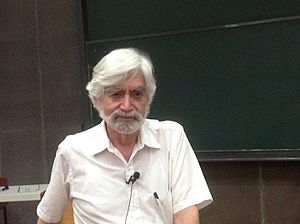George Zweig facts for kids
Quick facts for kids
George Zweig
|
|
|---|---|

George Zweig giving a speech at Department of Physics, National Taiwan University
|
|
| Born | May 29, 1937 Moscow, Russian SFSR, Soviet Union (now Russia)
|
| Citizenship | American |
| Alma mater | |
| Known for | Quark model |
| Awards |
|
| Scientific career | |
| Fields | Physics; neurobiology |
| Institutions | Los Alamos National Laboratory, Massachusetts Institute of Technology |
| Doctoral advisor | Richard Feynman |
George Zweig is an American physicist born on May 30, 1937. He is famous for helping to create the quark model. This model explains how tiny particles inside atoms are made. He worked with famous physicist Richard Feynman. Later in his career, Zweig also studied how the brain hears and understands sound. He has worked at important places like Los Alamos National Laboratory and the Massachusetts Institute of Technology. He also worked in the world of finance.
Contents
Early Life and Education
George Zweig was born in Moscow, which was then part of the Soviet Union. His father was an engineer who designed buildings and structures. George went to the University of Michigan and finished in 1959. He earned a bachelor's degree in mathematics, but he also took many classes in physics.
He then went on to get his PhD in theoretical physics. He studied at the California Institute of Technology and finished his degree in 1964.
Discovering Quarks
Right after finishing his PhD, George Zweig suggested a new idea in physics. He proposed the existence of tiny particles called "quarks." He did this at CERN, a big science lab in Europe. Another scientist, Murray Gell-Mann, also came up with a similar idea around the same time.
Zweig called these particles "aces." He thought there might be four types of them, like the four aces in a deck of cards. This idea of quarks was a huge step forward for understanding how matter works. It helped explain how particles like protons and neutrons are built. Protons and neutrons are found inside the center of atoms.
Quarks have special properties, including a fraction of the usual electric charge. Zweig's ideas helped explain why some particles decay (break down) in unusual ways. This led to a rule in physics called the OZI Rule, where the "Z" stands for Zweig.
In 1969, Murray Gell-Mann received the Nobel Prize for his work on elementary particles. At that time, the idea of quarks was still new and not fully accepted. So, the Nobel Prize did not specifically mention quarks. Later, in 1977, Richard Feynman tried to nominate both Zweig and Gell-Mann for the Nobel Prize, but it did not happen.
Later Work in Science and Finance
After his work on quarks, George Zweig became interested in how we hear. He studied neurobiology, which is the science of the nervous system. He researched how sound waves are changed into electrical signals that the brain can understand. This process happens in a part of the ear called the cochlea.
In 1975, while studying the ear, he developed a new mathematical tool. It was a version of what is now known as the continuous wavelet transform. This tool helps analyze signals, like sound waves.
In 2003, Zweig joined a company called Renaissance Technologies. This company uses advanced math and computers to make financial investments. It was founded by Jim Simons, who was a code breaker during the Cold War. Zweig worked there until 2010.
After a few years, in 2015, Zweig returned to the financial world. He started a new investment company called Signition with two younger partners.
Awards and Honors
George Zweig has received several important awards for his scientific work:
- MacArthur Prize Fellowship (1981)
- He became a member of the United States National Academy of Sciences (1996)
- Sakurai Prize (2015)
See also
 In Spanish: George Zweig para niños
In Spanish: George Zweig para niños

